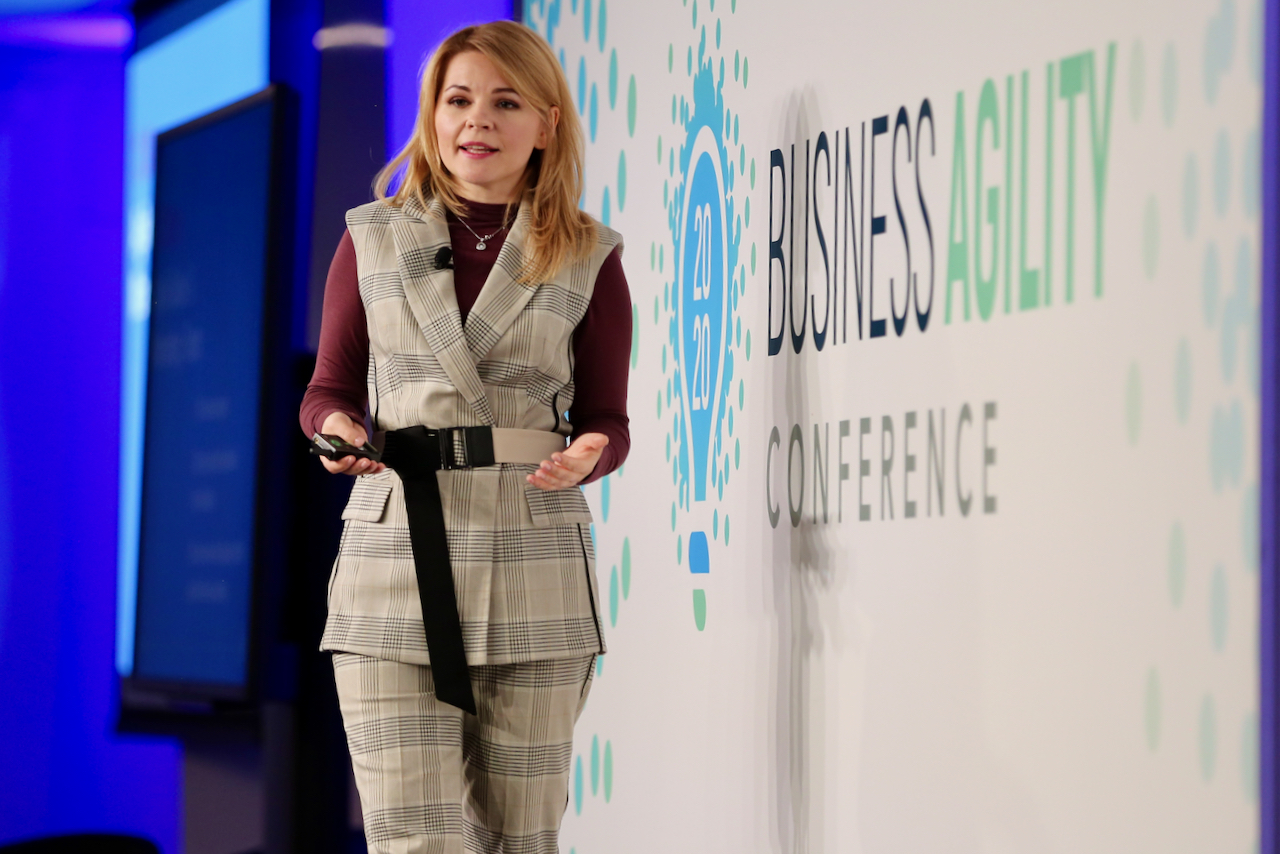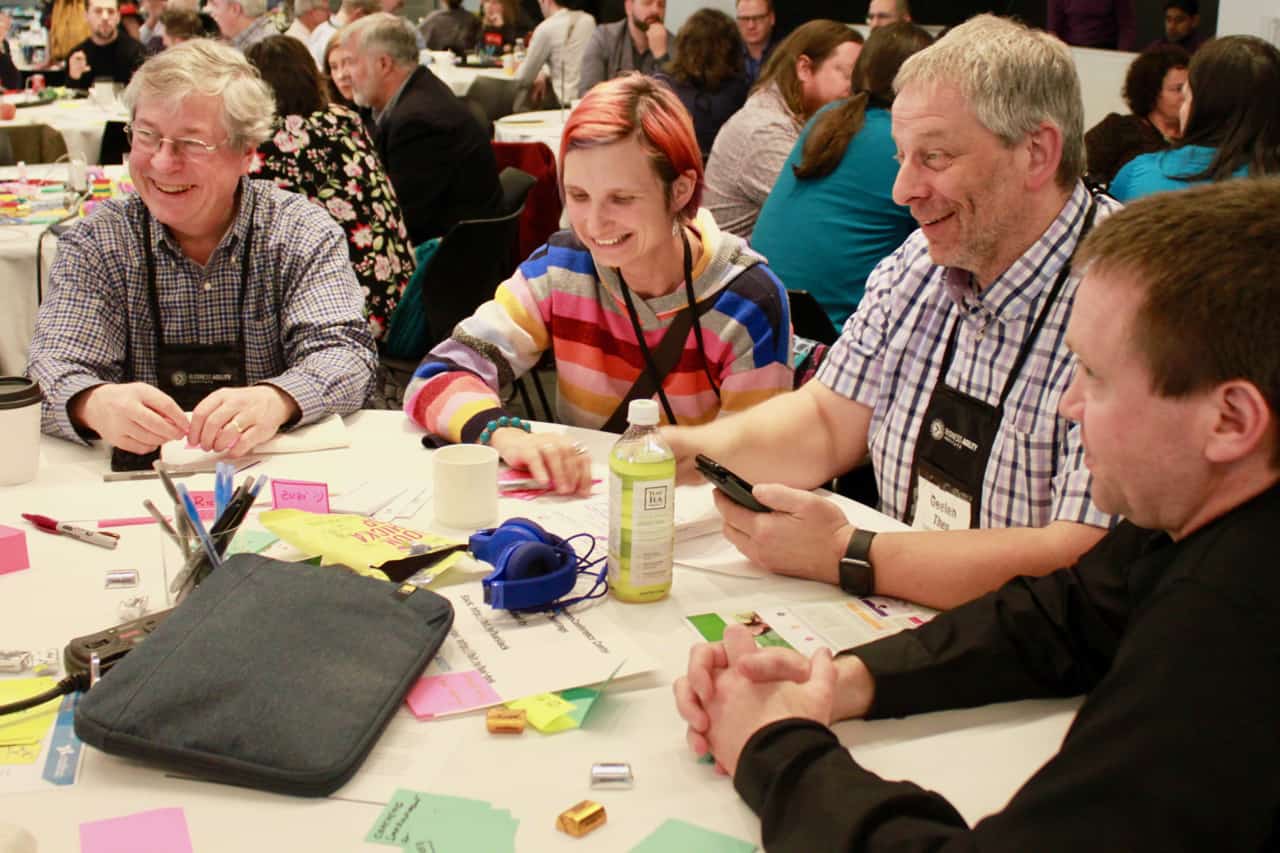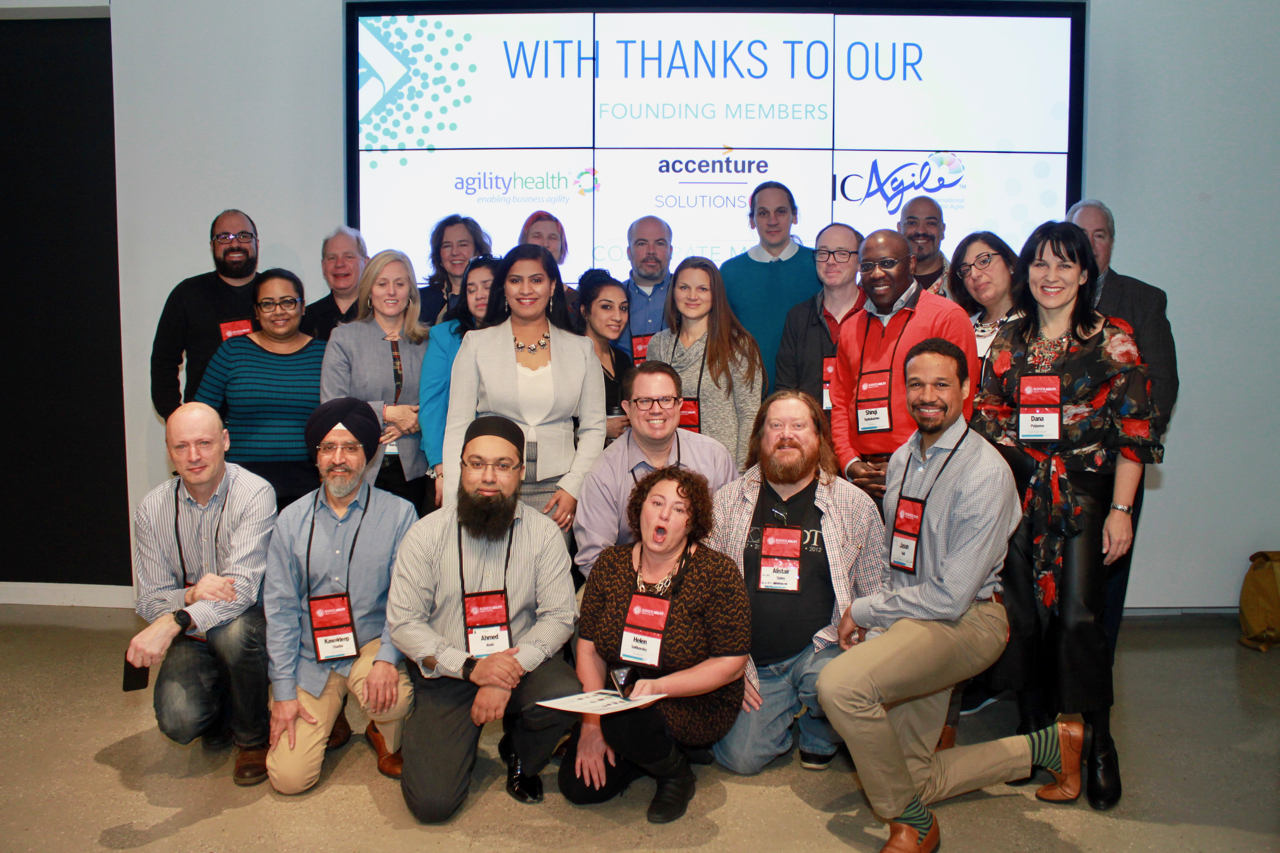Crowd-Control
Crowd-control is a complex issue in large crowds. I’m unsure of its origin, however we primarily use the “hands-up” method. This needs to be explained to the entire audience at the start of the conference, but usually works within 30 seconds. The rules are very simple;
- [Organisers] Raise your hand if you’d like silence and attention.
- [Participants] If you see anyone with their hands-raised you must immediately raise your hand, stop talking and face the front.
This has a viral effect, meaning that there will soon be a critical-mass of people suddenly silent causing others to look, see the hands and following suit.
Programme
Format
We believe that people don’t have long attention spans and so a Ted style approach works in most environments. Exceptions are hands-on technical or educational forums which require much deeper involvement and longer timeframes.

In terms of format, our recommended format is to break the day into three 2.5 hour sessions. Each session being defined around a topic, theme or audience. In the case of the Business Agility Conference is it Executives, Thought-Leaders and Practitioners – referring to the type of story the presenter is giving. Each sessions consists of three, 20 minute, “art of the possible” stories, a 20-minute Q/A with all speakers and a 45 minute “deep dive” (with relevant breaks throughout). In general, each session will have a dedicated host – someone to introduce the topic and the speakers.
Speakers are selected to tell authentic stories about their experiences. No ideas, frameworks, theories, and definitely no sales-pitches. We would also recommend limiting the number of regular speakers or common stories. In our experience, the audience has heard most of these stories before so they are of limited value. Sometimes it can be difficult to identify poor speakers beforehand, so we recommend watching examples of previous presentations or investing in the time to interview each speaker individually. We also encourage ongoing engagement with the speakers in the months leading up to the event.
What makes a good talk?
- The speaker taps into the audience’s curiosity
- The speaker shares real stories not just concepts. We want great story-telling.
- The story conveys a clear and focused idea or concept.
- The speaker / talk brings the audience on a journey one step at a time, and gradually build that idea up. Triggering curiosity is key for the audience to come on the journey with you.
- Initiating curiosity should typically happen the minute the talk starts. That’s often the best way to start a talk, with a question.
- People walk out of the session repeating something they heard word for word. Memorable, simple, clear and concise.
Selection Process
 We had a great success case (Renee Troughton) where we had a skype call with her to hear her pitch for her talk, and by accident she told us a story of a really bad day she had just had. We pulled on this story and ended up convincing her to focus her talk on that rather than just doing a talk on theory. Lesson here: Coaching calls are valuable and can help people hone in on their story (We did coaching calls for all short-listed submissions in 2018).
We had a great success case (Renee Troughton) where we had a skype call with her to hear her pitch for her talk, and by accident she told us a story of a really bad day she had just had. We pulled on this story and ended up convincing her to focus her talk on that rather than just doing a talk on theory. Lesson here: Coaching calls are valuable and can help people hone in on their story (We did coaching calls for all short-listed submissions in 2018).
We had a speaker that came referred through a friend of the conference. He was a big name (well known author). He didn’t engage much and it was hard to get a title and abstract out of him. He didn’t prepare very much for his talk. Lesson here: Vet everyone, even if they’re a big name.
- Doing a coaching call for every single submission (even once we short-listed) is VERY time consuming. We grouped them into evenings, 4 calls a night, 30 minutes a call (15 minutes between calls), and we were doing these calls on and off for weeks. Lesson here: If we’re going to do these calls we need to figure out a way to scale it out by training up more people for future years so this can be sustainable.
- Feedback we got from some people in our chats was that they didn’t realize we were looking for stories. Very few of the submissions were in the form of a story. Lesson here: Have better information on the submission system. We’re also considering making videos giving some walkthroughs of what we’re looking for so the initial submissions are better.
- Doing this call does not guarantee that someone will take your advice. You’re accepting their submission, and some people just chose to go off of what they’d written in their submission: Lesson here: Get people to update their submission before accepting there talk (we could also give written feedback before we even do a call with them). Don’t accept a talk until you can see for sure that they’re on the track we are looking for.
Formats
Facilitated Conversations & Deep Dives

Integral to successful events is the ability to “deep-dive”. That is to give participants the opportunity to learn from each other, share their own stories and converge from the “art of the possible” to “what am I going to do on Monday”.
A requirement of a good deep-dive is active facilitation. In our experience, each group of 10 people needs to have 1 facilitator to guide the discussions. Facilitators are not mini-speakers or leaders, their role is to ensure everyone has a voice, not to be a voice. Deep dives should be kept simple – this is not a training course – and be designed to encourage sharing and interaction as much as possible.
Potential deep dive formats include; canvases (e.g. business model), lean coffee, pitching, research, facilitated discussion, or simultaneous surveys. We would advise avoiding panels (there’s already Q/A) and anything with complex instructions.
Around The World Format
You can do a roundtable discussion using an around the world format, which means you start on one side of the table and then move one-by-one around the table until everyone has had a chance to speak. Each table should be posed a leading question to kick-start the conversation in the context of the previous session.
- Everyone speaks once. If you have additional comments, please write them down
- You have a maximum of 2 minutes. You WILL be timed.
- During your turn, please add any relevant comments that have not been shared yet.
- Keep the feedback focused on our objective.
Alternatively, open the floor to participants and allow for discussions to organically lead to the summary of the session. This requires very strong moderation.
Keep a sense of humor and have fun! We are all here to learn!
If you want to extend this into a World Cafe style approach, the participants can switch tables for additional rounds.
Lean Coffee
Lean Coffee is based very heavily on Personal Kanban and is very simple to learn. Before the session begins, the facilitator sets out a Kanban Board on the table with three columns; To Discuss > Discussing > Discussed. This represents the topics that we want to discuss, what we are currently discussing and what has been discussed.
“The format for a Lean Coffee is very simple. This is intentional. It is meant to be the least structure necessary for a coherent and productive meeting. No more, no less.”
At the start of the deep-dive the facilitator asks the participants to write down (on individual post-it notes) all the topics they’d like to discuss and add it to the “To Discuss” column. When enough ideas have been generated, each person spends 5 seconds outlining their topic so everyone understands the context. Duplicate topics can be discarded this way.
Now the table is ready to start. Each participant is given two votes (dots) which they can add to any topic. The topic with the most dots is the first topic, the second most is the second and so on. The “To Discuss” list can be re-voted on or changed at any point. The art of facilitation here is to know when to break the rules.
Simultaneous Surveys
Simultaneous Surveys is a fun way of collecting information from a large group of people. Everyone gets to walk around the room and meet people.
Facilitation Process
- 2 min – Setup and explanation. A list of questions is put up on the screen – these may relate to conference feedback, the session topic, or any other relevant topic. Each table will be given one question to conduct interviews with others at the conference.
- 12 min – Participants walk around and interview as many people as possible.
- 8 min – Come back to your table and write your story. Capture your themes on a flipchart.
- 5 min – Post the charts on the wall and share the headlines of the stories they captured (Roaming microphones to hear from just a few tables, we will not be able to hear from all.) Hang the posters and let people walk the walls as they are leaving.

General Facilitation Techniques
- Pause and let the flow of conversations happen: Count to 10 before you can respond to your audience, This allows for you to process your thoughts and your audience to express their thoughts
- Proactively enable points of interest among the participants. Learn about what the special interests of the participant are and pair them with the other participants with similar interests
- Establish working agreements and alignment expectations at the table upfront
- Answer questions with questions as a form of exploratory thought process
- Voice modulation and the power of tone. Assertive, affirmative and confident voice sets the tone of the table
- Participants – Share your intentions. Write your current intention or state of mind on a sticky and place it on yourselves to share your expressions and your expectation of learning from the conference
- As the speaker sessions are on, participants can summarize the high level points from the talks on stickies and add to the table board
- Visual facilitation – more to come on this
- Create a story trail by interviewing participants on the table – format and tool to enable this TBD
- Liberating structures
Facilitation Skill

Here are high level functions of the facilitator and the mindset they need to bring into the deep dive facilitation:
- Facilitator should to be articulate, confident and knowledgeable about the topics discussed by the speaker. This enables them to effectively guide the conversations around the table.
- Plan a very short ice breaker/fun introduction for the table
- Encourage the participants on each table to be collaborative and democratic in nature.
- Ensure time is managed carefully, with plenty of time for discussion.
- Facilitators should not dominate the discussions. Involve and encourage less confident participants. Recognize patterns in the discussions and lead the discussions to a desired outcome.
- Contain overzealous members of the table and keep the discussion moving in a reasonable but purposeful way. In other words, do not allow any one participant to monopolize the roundtable
- Stay on point/issue/target with the group as much as possible.
- Stay active, attentive, standing, engaged.
- Maintain a very positive, neutral, supportive, on-point attitude.
- Challenge thinking patterns.
- Use flipchart or any other visible tool for tracking the high points and to help manoeuvre the participants through the discussions.
- Appreciate people for their contributions to the discussion. This will encourage them to bring back more thoughts for the future sessions and bring introverts out of their shell.
- Lead to end at the high point of the discussion. This will be the sticking point or the main take away of the session.
- Develop thought-provoking, open-ended questions to get at and discuss the issues surrounding these topics (understand what the intent of the outcome is)
- Facilitators should assist in creating an environment of safety, non-judgment, respect and lively inquiry that fosters deep learning and curiosity at the same time. No one wants to speak up in an environment where they are judged or undermined.
As remuneration for their efforts, facilitators (except those provided by sponsors) should be provided with complimentary entry to the event and access to all event social events. A small link to their blog or LinkedIn profile may also included on the conference website.
Brainstorming
If the intention of a session is to reach a community consensus, while there are multiple approaches, we recommend a simple canvas + dot voting approach works quickly.
Canvas (Divergence)Any canvas approach can work, and designing a custom format for a specific purpose can often be effective. If you need a generic format try this 4 quadrant approach;
|
Dot Voting (Convergence)While it’s not perfect (have a read of the wikipedia page for criticisms), dot-voting is a quick and simple method for prioritizing a list of clearly understood options. The dot-voting process includes the following steps:
|
Session Hosts

The purpose of having hosts for each session is to design the best attendee experience for the session they are hosting and ensure that participants get a fulfilling and engaging exposure to the topic of the session. The role of the host is:
Prior to the conference:
- Contact your speakers and introduce yourself as the host as well as the role of the host. Get the introductions for each of the speakers.
- Double check if the sequence of the speakers in the session is ideal for the content experience.
- Ensure that the speakers will present top notch and relevant content.
- Ensure that speakers will stick to the 18 minute timeframe and not overload content (sort of like TED coaches for speakers – but less hands-on) (See the tips below).
- Decide on a deep-dive activity in collaboration with your speakers and conference organizers. Ensure that the deep-dive aligns well with, and is an extension of, your session’s talks. Create instructions for the facilitators regarding the deep dive.
- Work with the speakers to ensure their talks cover the necessary content for the deep dive session.
- If the deep-dive involves other people (e.g. a panel) then please make sure to coordinate with them.
During the conference session:
- Introduce the topic and get people excited about what is to come. This should not exceed 10 mins.
- Introduce each speaker (bio) between each speaker
- Ensure the session does not run over time. This is critical.
- Facilitate the deep dive (we can draft for volunteers/facilitators if needed)
Following the session:
- Thank the speakers and announce the break
